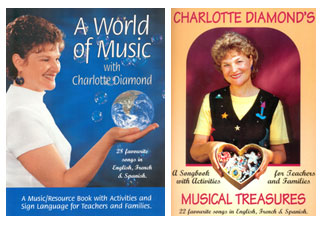Lesson Plans
Sample Lesson Plans
for Charlotte Diamond’s Music
The Hug Bug
(From Diamond in the Rough)
- Children can act out the moods as they sing the song – feeling sad, a sniffly cold, or falling off their bike. Then talk about other situations when we need a hug or a kind word to feel better. Discuss how to be a good friend, a caring brother or sister.
- Draw Hug Bugs or make them out of hearts (for Valentines Day) or Paper Bags Hug Bugs with six legs attached. Hug Bugs come in many different shapes, sizes and colours. Hug Bugs can be made as a gift for a parent or taken to a nearby Senior’s Facility.
- Vary the song by adding an echo to the chorus: “It’s the Hug Bug (Hug Bug), the Hug Bug (Hug Bug), the Hug Bug, Never know where it’s hiding…”
- What does a bug look like? Six legs, maybe 4 wings, antennae. “What has 8 legs?”
- Related Songs: “Four Hugs a Day,” “My Bear Gruff,” “Love Me For Who I Am,” and “Everyday Angel.”
I Am a Pizza
(From 10 Carrot Diamond)
- This is an excellent echo song and very easy to sing. Divide the group in two with one group leading while the other group echoes. One child may want to be the leader.
- Once the children know the song in English, teach a verse in French (on 10 Carrot Diamond) or in Spanish (on Soy Una Pizza).
- Use a felt board with the pizza shape and add different toppings. Using a pizza box with a felt pizza inside, act out the song.
- The children can draw pizzas, putting on the toppings that they like. Change the words of the song to suit their toppings. For example: “I am a Pizza…with lots of olives, some feta cheese…”
- Make pizzas in class so that the children truly become a Pizza. (We are what we eat!)
- Change the word “Pizza” to “Sandwich,” “Taco,” “Guitar,” etc. and create a new song (Zipper Method). For example: “I’m a guitar, made of wood. When you strum me, I sound good…”
- Discuss what foods we need to make a pizza – flour, tomatoes, onions, green peppers.
- Lead into “The Garden Song” or “Each of us is a Flower” or other growing songs.
- Once children learn the pattern of echoing, related songs and stories are: “Puddles,” “Sasquatch,” “Looking For Dracula,” “I am a Bubble,” and “Little Sir Echo.”
The Carousel and My Favorite Things
(From Diamonds and Daydreams)
- Use long ribbons or scarves to follow the rhythm of the music. With a smaller scarf, the children can play “throw and catch” to themselves or with a partner.
- Draw a large circle for the carousel and then add on horses that the children have made.
- Form a circle in the room and have the children ride their imaginary horse around the Carousel, moving up and down to the music. One child can be the Carousel operator who starts the music and the imaginary Carousel.
- Make a list of your favourite things. Discuss how we all like different things. “What is your favourite colour?” “What is your favourite ice cream?” … “Your favourite animal?”
- “What favourite things do we all like?”
- Read the book “My Favourite Things.” Make your own book of favourite things.
- Related Songs (All of these songs have 3/4, Waltz rhythm): “Fly High Unicorn,” “De Colores,” “My Bear Gruff,” and “Donne-moi la main (Give me your hand).”
La Bamba
(From 10 Carrot Diamond)
- Make simple percussion instruments to play along – Yogurt containers or film canisters, filled with pop corn kernels, macaroni or rice. Have only a small group play at one time so that the other children can listen. Can you identify a particular instrument?
- Create a simple dance or clapping pattern with the children. Have them work in pairs, then share their ideas with the group.
- Learn to sing the song in Spanish – teach only small sections at a time, using the “echo method” to introduce the words.
- Related songs: “Zulu Carol,” “All the Nation Like Banana,” “Feliz Navidad,” “Mi Caramelita,” and “All Mixed Up.”
10 Crunchy Carrots
(From 10 Carrot Diamond)
- Use your fingers as the carrots, making them disappear as you count down. Start with five crunchy carrots if the children are very young.
- Use real carrots at snack time, putting the child’s name in the song as s/he takes a carrot. The last carrot is shared between two children. Make music with the “Crunches.” Compare the crunch of a carrot with a piece of celery or an apple.
- Talk about how carrots are grown, that they are a “root.” Discuss the difference between a potato (tuber), celery (stem), lettuce (leaves) and tomato (fruit).They all begin as tiny seeds. Plant some carrots in a garden – and follow the growth of the seeds.
- Other Counting Songs: “Five Little Sparrows,” “Four Hugs a Day,” and “New Potato Polka.”
- Related songs: “The Garden Song” and “Each of Us is a Flower.”
Many more interesting teaching ideas for Charlotte’s songs are in her music books:

